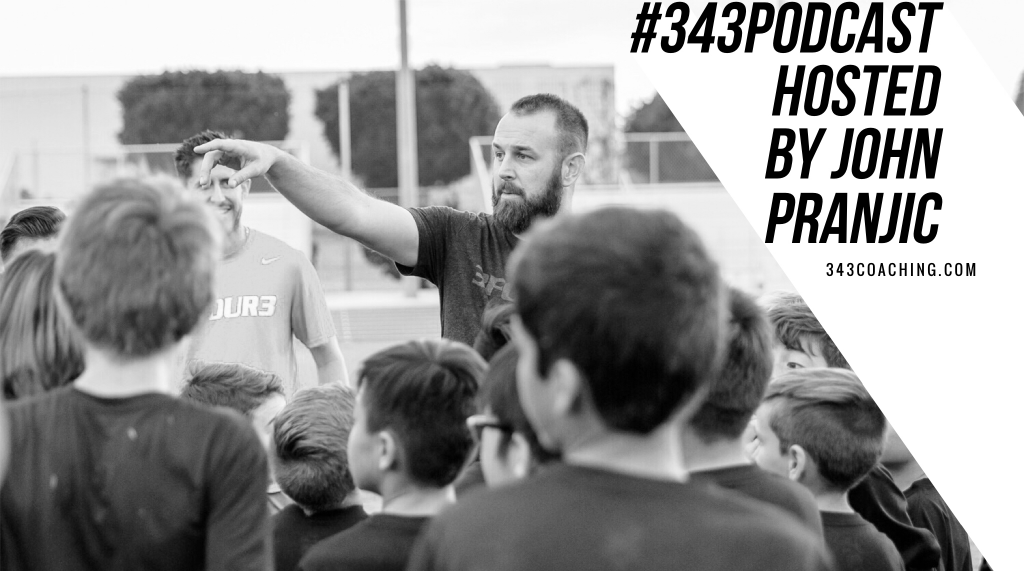

MLS, and many other soccer influencers, have painted parity as the holy grail for American soccer. They have said time and time again that parity is something good, but that’s just not true.
From a sporting sense, parity is a path to mediocrity and it is detrimental to the overall team, player, and coaching development in our country.
The MLS crowd believes and wants you to believe, that parity is good for development and good for American soccer.
Their exclusive professional and academy leagues are rooted in the belief that parity is what creates competition and should be the driving force behind developing and pushing players into our Men’s National Team program.
In the spirit of parity, MLS franchises are allocated the same amount of money for their rosters, the same number of designated player spots, and they even go as far as wearing the same brand and styles of jerseys.
It’s parity from head to toe.
The idea that parity is good for the sport of soccer in our country has trickled all the way down to the youth level.
In April 2020, it was announced that the USSF led Development Academy would be closing.
Just minutes after that announcement, MLS released a statement that it would be launching its own version of the academy league.
At the time, it was speculated that MLS Academies would have an exclusive league all to themselves. This was predicated on the fact that the Development Academy had already planned to split into different tiers, with all MLS franchise academies being in Tier 1, with other teams being placed in Tier 2.
In May 2020, these assumptions rang true with the announcement from MLS that their new academy league would be comprised of 95 clubs and franchises, 30 of which would be in the top tier. The remaining 65, which included no MLS franchises, would play in a separate lower tier.
According to an unnamed source and reported by The Athletic, “Concerns about the overall level of competition were the main motivation for putting MLS teams into their own division. A number of MLS clubs have long felt that their academy teams weren’t properly challenged in the DA. They repeatedly expressed those concerns in recent years to both MLS and U.S. Soccer.”
You see, people involved in the MLS Academies believe that playing against inferior opposition, which is a polite way of saying traditional youth clubs that are outside of their MLS franchise network, is bad for their teams, players, and coaches.
People involved in MLS Academies believe that they need to get rid of these games against “inferior” opposition and that every game between MLS Academies should be a hard-fought 1-1, or 1-0, or 2-1 result.
This is totally misguided.
There is a ton of value from playing a mix of significantly inferior and superior opposition and getting these games in a variety of ways.
Whether that’s through scrimmages, tournaments, or, ideally, merit-based league play, playing a mixed bag of opponents actually helps development, not hinders it.
There is a global precedent on this subject matter. Youth academies all around the world face a variety of opponents at every level. Whether it’s U10’s or U18’s, in Spain or in Holland, teams and players could face a monster one week, and a minnow the next.
For example, FC Barcelona’s youth teams regularly face local opposition that is far inferior to them. They frequently win games 5-0, 8-0, and even 10-0. And doing so has not impacted the club’s ability to routinely pump out world-class professionals.
The same can be said about Ajax, Porto, Dinamo Zagreb, and many other well-known clubs across the globe.
The inverse should also be addressed.
Facing monsters like FC Barcelona or Ajax doesn’t hurt the development of other clubs. In fact, this better prepares them for facing equal or lesser caliber opponents in their future.
So, let’s discuss the benefits of playing against significantly inferior and superior opponents. Or, playing up and playing down.
We’ll start by talking about playing down.
The Benefits of Playing Down
“Playing down” has a negative stigma attached to it. And I want to address that right away so we can move beyond it and discuss the benefits.
When you hear the phrase “playing down” it sounds like older teams beating up on younger teams for fun.
But in a competitive environment that is truly concerned about developing top-level players for the professional and international game, that’s not the case at all.
Yes, playing down could mean playing against younger opponents.
It could also mean playing against opponents of the same age but of a lower level. For example, a Gold team playing against a Silver team.
Additionally, it could mean playing opponents at the same level, both Development Academy teams for instance, but one is top of the league and the other is at the bottom.
While some may think playing down is unfair, or unproductive, it’s actually a valuable tool. Not just for the team that is playing down, but also for the team playing up. (We’ll have more on that later.)
When it comes to playing down, it’s all about how that tool is used.
So, when MLS franchises are complaining that games against inferior opposition are unproductive, that means they don’t know how to use the tool they’ve been handed.
For example, playing down enables:
- Coaches to improve their execution of team tactics. Because, yes, coaches need development, too. This will, in turn, lead to better team and player development.
- Teams to demonstrate comprehension, and eventually mastery, of the coaches game plan. The goal here should be winning against opponents through proper execution of that plan, not just through hard work and guts.
- Individual players to demonstrate confidence, creativity, and flair due to the lower risk of failure, extra space, and extra time on the ball.
Yep, it’s all how you look at it.
Playing in these types of games can be a morale booster, giving the players, the team, the coaching staff, the club, and the parents a sense of confidence that the plan is working and development is actually happening.
Ideally, playing down would be a natural part of league play. Around the world, this is achieved by playing in open systems with promotion and relegation. This is a mechanism that truly allows the cream to rise to the top, and for the weak links to be filtered to their appropriate levels.
In no way, shape, or form are we advocates for parity and what MLS has built at the professional and youth levels. Having said that, we understand the landscape and would still like to offer insight and solutions despite the unfortunate circumstances.
So, how can playing down be achieved?
Here are some general examples:
- High school varsity teams scrimmaging their JV teams before their next game.
- Top European clubs playing MLS franchises during their pre-season tours.
- National Teams playing against club or academy teams during camps.
But notice that the common thread in these examples is that there is a significant difference in the level between the two teams. That is what best enables the development to take place in these particular situations.
When it comes to youth club soccer, this type of playing down can easily be achieved by organizing scrimmages, friendlies, or even intra-club matches against teams of a lower level.
This creates a situation in which everyone understands the benefits and objectives.
Another way this can be achieved is by entering lower-level tournaments. Not playing down in age, although that certainly could be an option in some areas, but playing against teams that are significantly below your level. For example, if you are a gold level team, enter a bronze level tournament.
Keep in mind – playing down is not meant to be a long-term solution. Just like you shouldn’t want parity, you shouldn’t want to play down 100% of the time. This is a tool to be used at the right time to produce the right results, whatever those might be for your situation.
A real-world example of playing down.
What some might not know is that in order to prepare for the 2014 World Cup in Brazil, Jurgen Klinnsmann brought the U.S. Men’s National Team together for a camp at Stanford University in Palo Alto, CA. During that time, the Men’s National Team regularly faced off against inferior opposition, including college opponents and USL II teams, in order to test out tactics, different line-ups, and to refine the teams playing style.
Jurgen, like many other coaches, used this opportunity to play down as a way to solidify his roster before traveling to Brazil. He said that “there were several ’50-50′ position battles all over the US squad.” These scrimmages helped him decide his final roster. As some might remember, this is the same camp that ended with Jurgen infamously leaving Landon Donovan at home following his sabbatical from soccer.
What’s the Deal With Playing Up?
Just like playing down, playing up can offer a ton of value.
But playing up poses a whole new set of challenges for coaches, teams, and individuals.
Those could include, but aren’t limited to:
- Learning to cope with physically, tactically, and/or technically superior opponents.
- Managing the psychological aspects and overcoming the mental obstacles attached to playing up.
- Figuring out how to create goal-scoring opportunities against teams that are bigger and faster.
If you’re competing in an environment in which parity governs everything, then you are missing out on these key developmental experiences that playing significantly superior opposition offers.
Again, there is a global precedent that playing against superior opponents could actually help raise the level of inferior teams.
Again, we’ll use Spain as an example.
As teams compete in La Liga against the likes of FC Barcelona and Real Madrid, they are actually becoming better prepared for other challenges that they may face in the future.
One could argue that this is why Spain has been so dominant in the Europa League in recent history, winning six of the last ten titles.
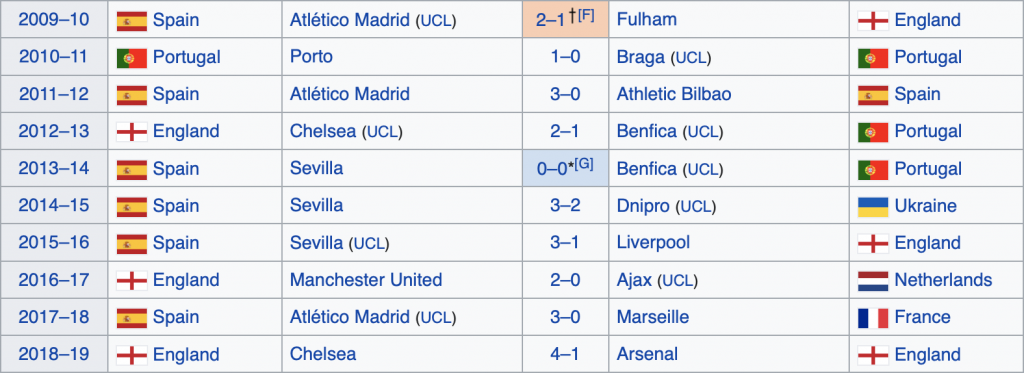
For reference, Spanish teams have claimed six of the last ten Champions League titles as well.

Meanwhile, even the strongest MLS teams struggle in CONCACAF Champions League and have failed to win a title since 2000. Since then, only three MLS teams have even reached the final, two of which reside in Canada.
This is a sharp contrast to the environment we see in Spain and other countries around the world.
But, given the state of things in our country, how can playing significantly superior opponents be achieved at the youth levels in America in order to elicit development?
Well, you could easily use the same examples that we recommended in regard to playing down.
For example, playing scrimmages against a higher level or older teams.
If you’re the B-team in the club, scrimmage the A-team.
If you’re the best U15 team in the league, arrange to play a team from the U16 division.
As we alluded to in Episode 259, Brian Kleiban has been somewhat of a pioneer in playing individual players and entire teams up.
Here are two ways that he accomplished this:
1) Playing up an entire age group in tournaments.
In order to test themselves, Brian’s teams would enter tournaments by playing up an entire age group. This meant his U11’s would enter the U12 bracket. The same was done at U-12 and U-13. On a number of occasions, his teams would win these tournaments.
It is important to note that the challenges of playing up from U11 to U12 are vastly different than playing up at U14 against U15.
2) Playing higher level tournaments.
There is a big difference between playing up in age versus playing higher quality opponents.
For example, Brian took his teams to MIC Cup in Spain where they played age-appropriate but faced higher level teams like FC Barcelona and Ajax.
3) Playing teams up during league competition and playoffs.
This was primarily done by promoting a number of younger players to a higher team. As you can see in the images (provided on 343coaching.com), Brian’s players faced opponents one, two, and even three years older than them, with the average age difference frequently being greater than one year.
And in his case, this was done with great success on many occasions. Not only in regular league play but also in the Development Academy playoffs and even the finals.
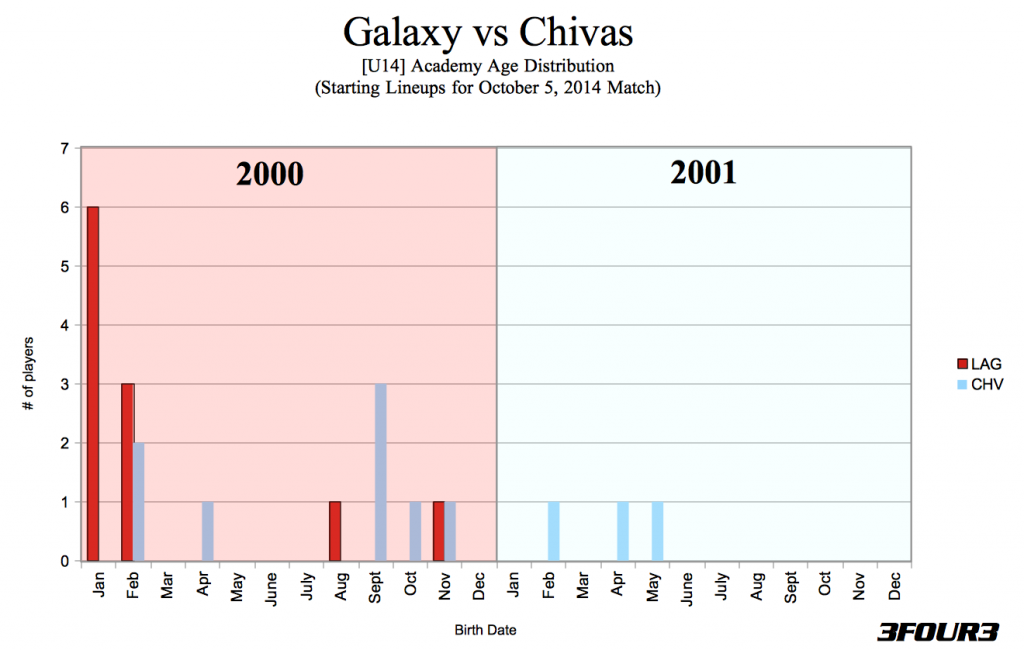
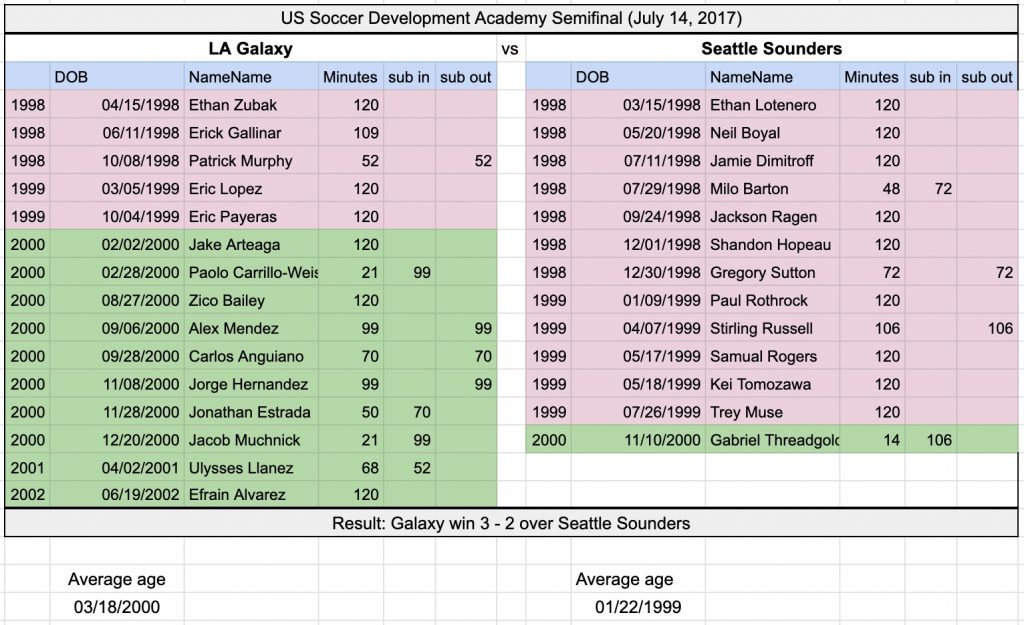
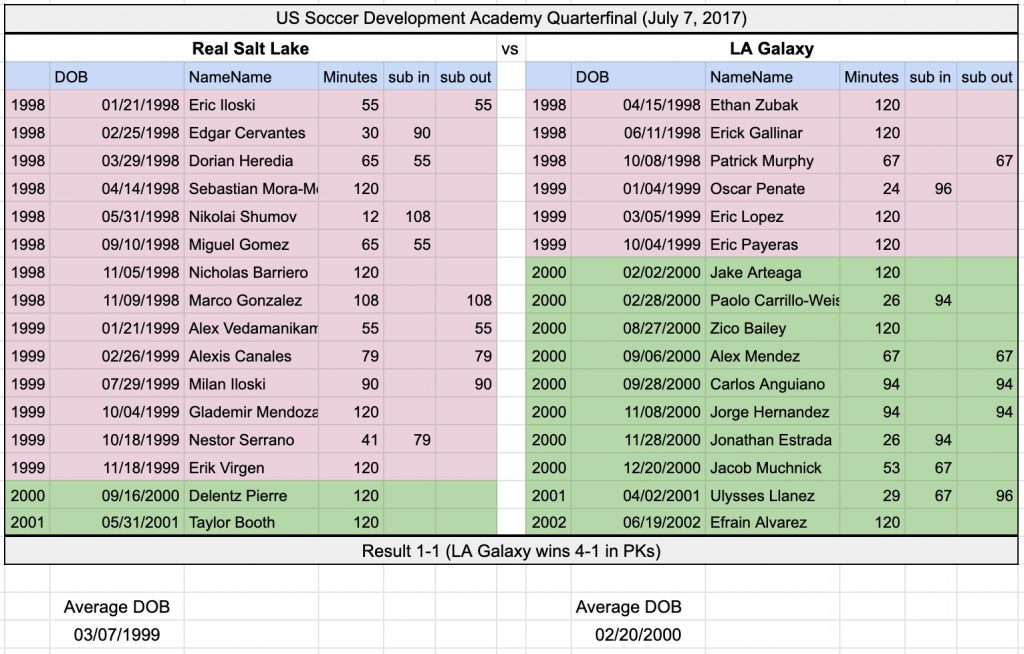
Okay, but what is the Ultimate Solution?
The Ultimate solution is having a diverse, open pyramid that has a variety of opponents at each level, from youth all the way to the pros,
Together, MLS and USSF have failed to offer this option to the detriment of American soccer.
By design, MLS franchises must participate in a system driven by parity. The rules and policies controlling the league are intentionally designed to ensure that parity is achieved.
Some examples of this are the playoff system, draft picks, and no promotion/relegation.
And while the appearance of a league table at the professional and academy levels suggests there are top and bottom teams, it is more a less a ruse when all things are considered. The intention is and always has been to create an equal playing field amongst MLS franchises.
In Spain, however, we see a wide array of clubs, all with different capabilities, resources, and objectives competing at all levels of their pyramid, in both professional and youth settings.
For example, FC Barcelona competes against top international clubs such as Real Madrid, but also against clubs struggling to stay in the first division such as Mallorca. The next year, they’ll face newly promoted clubs, while always being at risk of slipping from the top spots themselves.
While all of the clubs in La Liga are technically in the same division, there is certainly a difference in level amongst the teams.
Additionally, they all run their independent clubs much differently.
Keep in mind, an open-system means that miscalculations have consequences. A draw here, or loss there could have title implications, or in some cases, lead to relegation. This is the X-factor that MLS denies through their parity driven environment and cannot be recreated with any other gimmick.
At best, MLS offers a simulated version of these situations at the professional and academy levels. And if USSF believes that MLS’s parity approach should be the driving force in American soccer, we shouldn’t expect to achieve even remotely similar outcomes of the world’s best clubs, leagues, or national teams.
Conclusion
So, from a purely developmental standpoint, facing a mixture of opponents that are at your own level, below your level, and above your level provides a much more comprehensive and beneficial approach to the overall team, player, and coach development.
From a competitive standpoint, playing significantly superior and inferior opponents is beneficial to all. Whether you’re playing up or down, there is something to be gained and lessons to be learned. It’s all about your perspective and how you use the tools.
Never miss new episodes:
- Subscribe to 3four3 FM on iTunes
- Subscribe to 3four3 FM on Stitcher
- Subscribe to 3four3 FM on Spotify
Coaching Education Program
This is brought to you by the 3four3 coaching education program.
Learn more and join over 400 coaches using our proven possession-based methodology.
Leave a Reply